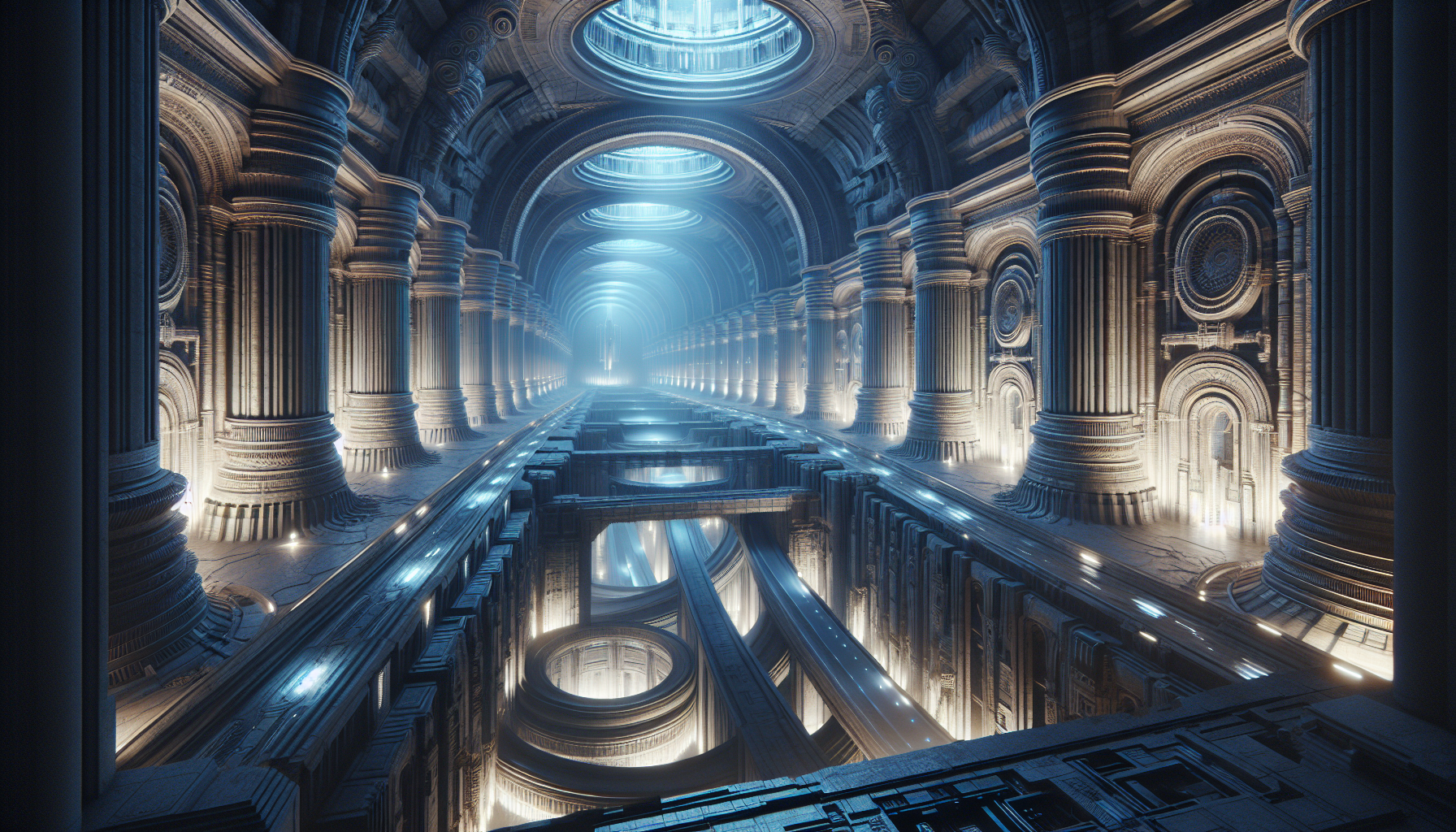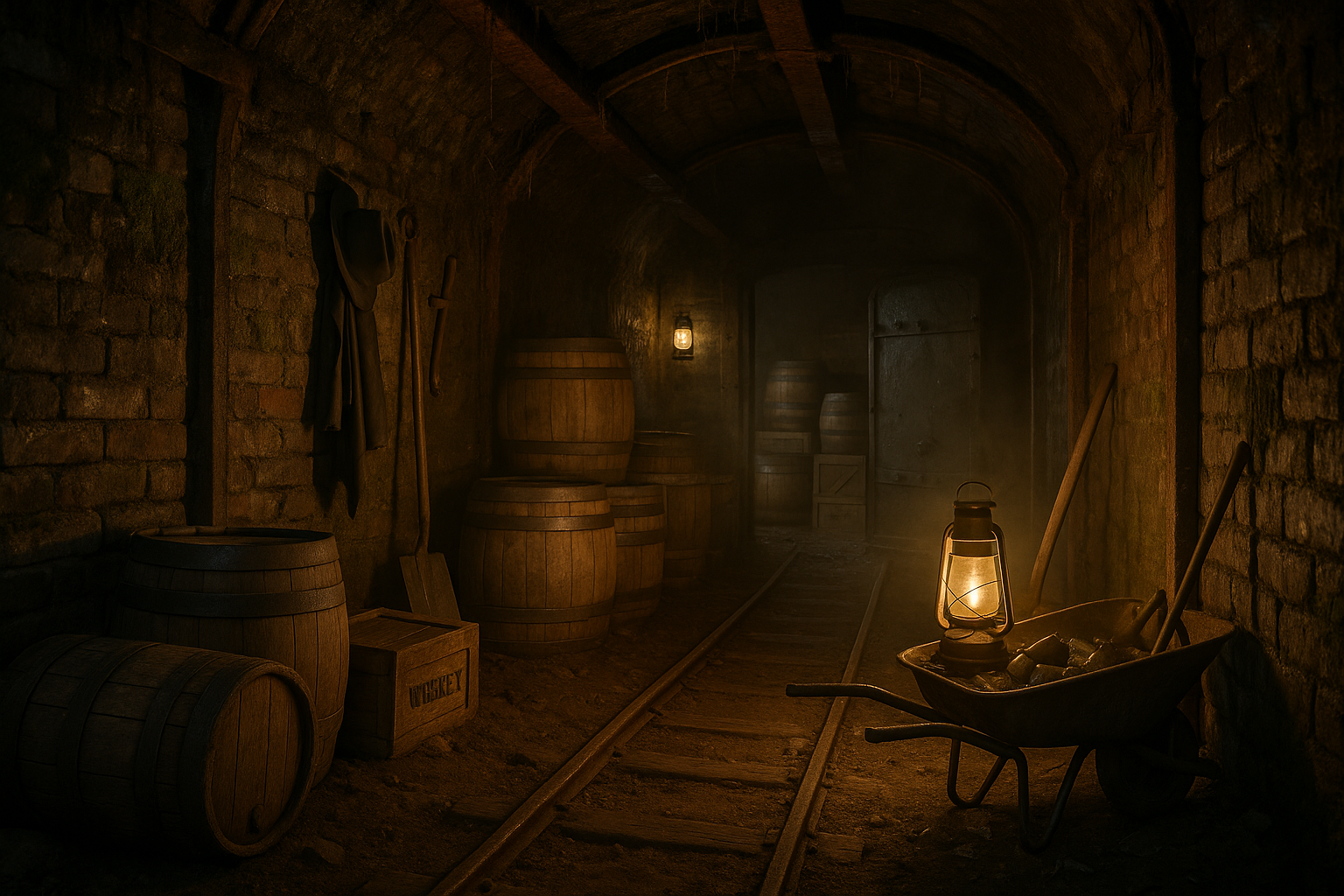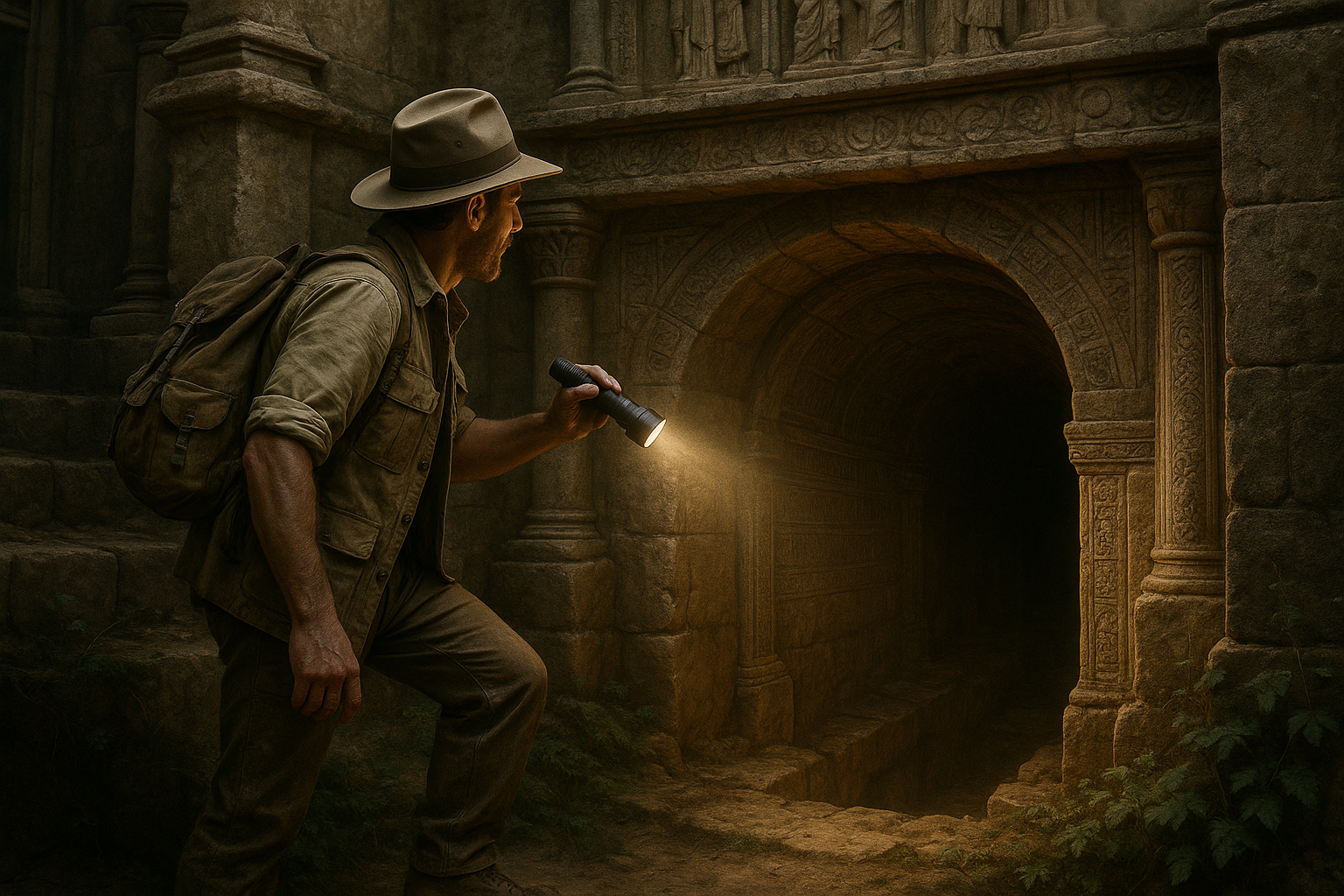In a world where architectural marvels reach for the sky, captivating our imaginations with towering skyscrapers and sprawling metropolises, there exists a parallel realm of wonders that often goes unnoticed beneath our feet. Welcome to the fascinating world of subterranean structures, where human ingenuity meets the earth’s silent embrace to create breathtaking designs and functional spaces. 🏗️ In this article, “Subterranean Splendor: Unveiling the Ingenious Design of Underground Structures,” we delve deep into the art and science of building beneath the surface, exploring how architects and engineers have transformed challenges into opportunities, crafting spaces that are as mesmerizing as they are practical.
From ancient cave dwellings that sheltered early civilizations to modern underground cities and transportation systems, the allure of subterranean design lies in its ability to harmonize with nature while offering protection and sustainability. The underground realm offers a unique canvas for creativity, pushing the boundaries of traditional architecture and inspiring innovative solutions to the challenges posed by urbanization, climate change, and resource scarcity. As we journey through this hidden world, we will uncover the secrets behind some of the most iconic underground structures, exploring how they reflect the evolution of human needs and technological advancements.
Our exploration will take us from the subterranean depths of Cappadocia’s ancient underground cities, where early Christians sought refuge, to the sleek, futuristic designs of modern metro systems that pulse beneath bustling urban centers. We’ll examine the engineering marvels of subterranean infrastructures like the Channel Tunnel, which links the United Kingdom and France beneath the English Channel, and delve into the environmental considerations that guide the creation of eco-friendly underground spaces, such as subterranean parks and urban farms. Each of these structures tells a story of visionaries who dared to dream beneath the surface, blending artistry with functionality to redefine the limits of what is possible.
As we unveil the ingenious design of underground structures, we invite you to imagine a world where the boundaries between the built environment and the natural world are not only blurred but harmoniously intertwined. Whether it’s the quest for more sustainable living spaces, the need for resilient infrastructure in the face of natural disasters, or the sheer beauty of a hidden, underground oasis, the subterranean realm holds the potential to transform our future in ways we are only beginning to understand. Join us as we embark on this underground adventure, discovering the splendor that lies beneath and the visionary minds that bring these incredible spaces to life. 🌍
The Evolution of Underground Structures
Underground structures have been an integral part of human civilization since ancient times. From the catacombs of Rome to the intricate cave dwellings of Cappadocia, the concept of building beneath the surface has fascinated architects and engineers for centuries. This practice, often driven by the need for protection and efficient use of space, has evolved significantly, adapting to modern needs and technologies.
The advent of advanced construction techniques and materials has allowed architects to push the boundaries of what can be achieved underground. Today’s subterranean structures are not just about creating shelter or storage; they are about leveraging the unique environment that lies beneath the earth’s surface to solve contemporary challenges. These structures provide solutions for urban congestion, offer stable temperatures, and, in many cases, present a more sustainable option for new developments.
In this section, we will delve into the historical context that gave rise to underground construction and examine how these practices have evolved over time. We will also explore the modern applications of subterranean structures, highlighting their significance in today’s world.
Historical Context and Ancient Innovations
The use of underground spaces is not a novel idea. Historically, societies have turned to subterranean construction for various reasons, ranging from protection against invasions to climate control. Ancient Egyptians, for instance, built elaborate tombs beneath the ground to protect the resting places of their pharaohs. Similarly, the ancient city of Derinkuyu in Turkey is a testament to the ingenuity of early civilizations in creating extensive underground living quarters that could house thousands of people.
These early underground structures were often driven by necessity, as they offered refuge from external threats and environmental conditions. The structures were designed with remarkable precision, considering ventilation, water supply, and even security measures. Such innovations laid the foundation for future developments in underground architecture.
As time progressed, the motivations for building underground evolved. In the Middle Ages, underground passages and vaults were often constructed for religious purposes or as storage areas for valuable goods. The trend continued into the industrial revolution, where underground construction became a practical solution for expanding urban centers and addressing infrastructure needs.
Modern Applications of Underground Structures
Today, the application of underground construction has expanded beyond traditional uses. Modern technology has enabled the creation of sophisticated subterranean environments that serve various purposes, from transportation networks to residential and commercial spaces. Below, we will explore some key areas where underground structures are making a significant impact.
Transportation Infrastructure
One of the most prominent uses of underground construction in the modern era is in transportation infrastructure. Urban areas worldwide face the challenge of increasing population density and limited surface space. Underground rail systems, such as subways and metro lines, provide an efficient solution for mass transit in crowded cities. These systems reduce surface congestion, improve mobility, and contribute to the economic vitality of urban centers.
For example, the London Underground, one of the oldest and most extensive underground rail networks globally, continues to evolve with new lines and technologies. Similarly, countries like Japan and China have invested heavily in underground transportation networks, showcasing the potential of subterranean spaces to revolutionize urban transit.
Moreover, underground tunnels are not limited to passenger transportation. They are also crucial for freight movement and utility distribution. Tunnels can house pipelines, electrical cables, and communication lines, ensuring essential services remain uninterrupted even in densely populated areas.
Residential and Commercial Spaces
Beyond transportation, underground spaces are being creatively used for residential and commercial developments. Architects are exploring innovative designs that incorporate natural lighting and ventilation, creating comfortable living and working environments below the surface. These spaces offer privacy, security, and a unique aesthetic appeal, making them increasingly popular in cities where real estate prices are soaring.
In countries like Switzerland and Norway, underground homes have gained popularity due to their energy efficiency and minimal environmental impact. These homes often utilize geothermal energy, which provides heating and cooling by harnessing the stable temperatures found underground.
For commercial purposes, underground shopping malls and entertainment complexes are becoming common in urban centers. These developments offer a seamless blend of functionality and sustainability, allowing cities to expand without encroaching on valuable green spaces.
Challenges and Innovations in Underground Design
Despite the numerous advantages of underground structures, there are inherent challenges in their design and construction. These challenges include geological considerations, cost implications, and the need for advanced technologies to ensure safety and stability. However, innovations in engineering and materials science are addressing these issues, paving the way for more ambitious underground projects.
Geological and Environmental Considerations
One of the primary challenges in underground construction is understanding and mitigating geological risks. The stability of underground structures depends heavily on the type of soil or rock in which they are built. Engineers must conduct thorough geological surveys to assess factors such as soil composition, water table levels, and seismic activity before construction begins.
Environmental impact assessments are also crucial, as underground projects can disrupt local ecosystems. However, with careful planning and the implementation of sustainable practices, these impacts can be minimized. For instance, the use of environmentally friendly construction materials and techniques can reduce the carbon footprint of underground developments.
Technological Advancements
Technological advancements are revolutionizing the way underground structures are designed and constructed. The use of Building Information Modeling (BIM) and advanced 3D modeling allows architects and engineers to visualize and plan projects with unprecedented accuracy. These tools enable the simulation of various scenarios, helping to identify potential issues before construction begins.
Furthermore, innovations in tunneling machinery and construction techniques have significantly reduced the time and cost associated with underground projects. Tunnel Boring Machines (TBMs), for instance, are now more efficient and can operate in a variety of geological conditions. This technology is crucial for large-scale projects like subway systems and cross-border tunnels.
Comparative Analysis of Underground Structures
Let’s examine the various types of underground structures and their unique features through a comparative analysis. The table below highlights key differences and similarities among different applications of subterranean architecture:
| Type of Underground Structure | Primary Purpose | Key Features |
|---|---|---|
| Transportation Tunnels | Mass Transit and Freight | Efficient, Reduces Surface Congestion, Requires Extensive Planning |
| Residential Spaces | Living Quarters | Energy Efficient, Sustainable, Unique Aesthetic |
| Commercial Complexes | Retail and Entertainment | Maximizes Space, Blends Functionality and Design, Minimal Environmental Impact |
As seen in the table, underground structures serve diverse purposes, each with its distinct set of features and benefits. This diversity underscores the versatility of subterranean spaces and their growing importance in contemporary architecture and urban planning.
Future Prospects and Emerging Trends
The future of underground structures is promising, with emerging trends suggesting a continued expansion of this innovative architectural approach. As cities become more crowded and land becomes scarcer, the demand for subterranean solutions will likely increase. Additionally, with advancements in technology and a growing emphasis on sustainability, underground construction is poised to play a critical role in addressing global challenges.
Sustainable Urban Development
Sustainability is at the forefront of modern urban development, and underground structures are no exception. These spaces offer significant energy savings due to their natural insulation properties, reducing the need for heating and cooling. Moreover, by utilizing underground spaces, cities can preserve valuable surface land for green spaces and public amenities.
Innovative designs, such as the incorporation of solar tubes and smart ventilation systems, are enhancing the sustainability of underground developments. These features ensure that underground spaces are not only functional but also environmentally friendly, aligning with global sustainability goals.
Technological Integration
The integration of smart technologies is another trend shaping the future of underground structures. Internet of Things (IoT) devices, advanced lighting systems, and automated controls are being used to create intelligent environments that enhance comfort and efficiency. These technologies enable real-time monitoring and management of underground spaces, ensuring optimal performance and safety.
Moreover, the use of augmented reality (AR) and virtual reality (VR) in the design and planning stages is revolutionizing how underground projects are conceptualized. These technologies allow stakeholders to experience and interact with the space before it is built, facilitating better decision-making and collaboration.
Global Case Studies
Several notable underground projects around the world exemplify the potential of subterranean architecture. The Crossrail project in London, for example, is one of the largest and most ambitious underground rail projects in Europe. It integrates advanced tunneling techniques and sustainable practices to enhance the city’s transportation network.
In Singapore, the Marina Bay Sands underground mall showcases the commercial potential of underground spaces. This development combines retail, dining, and entertainment, offering a vibrant urban experience while preserving the city’s limited land resources.
To gain a deeper understanding of the innovative designs and technologies being applied in underground construction, we recommend watching the following video:
Subterranean Architecture: The Future of Urban Design – Channel: ArchDaily
- Understand the historical context and evolution of underground structures.
- Explore modern applications and the impact on urban development.
- Discover emerging trends and technological advancements shaping the future.
As we continue to explore the potential of underground spaces, the integration of cutting-edge technologies and sustainable practices will undoubtedly lead to more innovative and transformative designs. The world beneath our feet holds immense possibilities, waiting to be unlocked by the architects and engineers of tomorrow.

Conclusion
In conclusion, the exploration of subterranean structures reveals a fascinating interplay between human ingenuity and the natural world. Throughout this article, we’ve journeyed through the depths of underground design, uncovering the remarkable ways in which architects and engineers have harnessed the power of the earth to create innovative and sustainable structures. From ancient civilizations to modern metropolises, underground spaces have served various purposes—providing refuge, conserving energy, and expanding urban landscapes. 🌍
One of the key points highlighted was the historical significance of underground structures. Early examples, such as the catacombs of Rome and the subterranean cities of Cappadocia, demonstrate the adaptability and resourcefulness of past societies. These spaces were not only practical but also held cultural and religious importance, showcasing the multifaceted role of underground environments in human history.
As we moved into the present, the article examined contemporary advancements in subterranean design. Modern architects are increasingly turning to underground spaces as a solution to the challenges of urbanization, climate change, and resource conservation. Structures like the Lowline in New York City and the massive underground parks in Singapore exemplify how these designs can offer both aesthetic appeal and environmental benefits. By utilizing natural insulation and reducing the need for external energy sources, underground buildings contribute significantly to sustainable urban development.
Furthermore, we explored the technical aspects and innovations driving the evolution of underground architecture. Advances in materials, engineering, and technology have enabled the construction of complex and resilient underground spaces that can withstand the pressures of the earth and the demands of modern society. From the use of reinforced concrete to cutting-edge ventilation and lighting systems, these innovations ensure that subterranean structures are safe, functional, and comfortable for their occupants.
The social and psychological impacts of living and working in underground environments were also considered. While there are challenges, such as the potential for feelings of isolation or disconnection from the natural world, thoughtful design can mitigate these effects. Incorporating elements such as natural light, green spaces, and open layouts can enhance the livability of these spaces, promoting well-being and productivity.
Ultimately, the exploration of underground structures is not just a study of architecture and engineering; it is a reflection of our relationship with the earth and our ability to adapt to the changing needs of our world. As urban populations continue to grow and environmental concerns become more pressing, the potential of subterranean spaces as a viable and sustainable solution becomes increasingly apparent. 🌱
In light of these insights, it’s crucial for professionals in the fields of architecture, urban planning, and environmental science to continue to innovate and collaborate, pushing the boundaries of what is possible underground. The potential for subterranean spaces to reshape our cities and lives is immense, and embracing this potential could lead to more sustainable and resilient urban environments.
As you reflect on the concepts and examples discussed in this article, consider the ways in which underground design might influence your own surroundings or professional pursuits. How can the principles of subterranean architecture be applied in your community? What innovations might you contribute to this evolving field?
We encourage you to share your thoughts and experiences related to underground structures in the comments section below. Engaging in discussions with others interested in this topic can inspire new ideas and foster a deeper understanding of the possibilities that lie beneath our feet. Moreover, sharing this article with your network can help spread awareness of the importance and potential of subterranean design.
For further reading and exploration, you might find the following resources insightful:
– National Geographic on Subterranean Architecture
– The Guardian’s Coverage on Underground Urbanism
– Scientific American’s Insights on Underground Space Utilization
In closing, the subterranean realm offers a unique opportunity to rethink how we live and interact with our environment. As we unveil the ingenious design of underground structures, we are not only uncovering the physical layers of the earth but also the layers of human potential and creativity. Let us embrace this journey with curiosity and determination, as we continue to build a world that is both sustainable and inspiring. 🌟
Toni Santos is a visual storyteller and artisan whose work explores the quiet power of what lies beneath. With a deep fascination for subterranean and hidden architecture, Toni uncovers the layers, voids, and forgotten spaces that shape our built environment from the shadows.
His art is a journey through the unseen — from ancient underground chambers to sealed passageways, service tunnels, and foundations buried in time. Each creation tells a story of silence, secrecy, and structure — revealing how absence and concealment can be just as meaningful as what’s visible above ground.
Whether working through visual compositions, architectural studies, or symbolic handcrafted pieces, Toni captures the soul of hidden spaces. His work bridges art and archaeology, blending design with discovery. Trained in visual design and traditional techniques, Toni creates with intention. His pieces don’t just depict — they interpret, inviting viewers to rethink what space, memory, and architecture mean when they’re hidden from view.
As the creative force behind Vizevex, Toni shares this perspective through curated visual narratives, symbolic collections, and interpretive essays that give voice to the quiet geometries beneath our feet.
His work is a tribute to:
The mystery of spaces built to be forgotten
The symbolism embedded in foundations, voids, and passageways
The timeless connection between human intention and hidden structure
Whether you’re an artist, an urban explorer, or someone fascinated by the unseen frameworks that support our world, Toni invites you into a realm where architecture becomes myth — one corridor, one layer, one buried story at a time.





